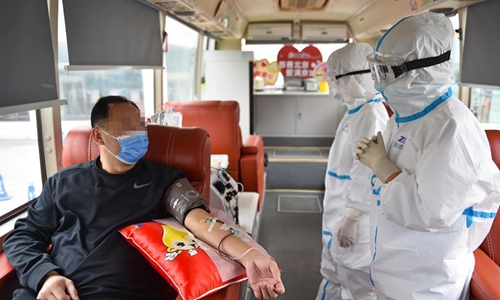HOME >> SOURCE
People with blood type A may face a higher risk of contracting COVID-19: study
Source:Global Times Published: 2020/3/17 18:03:40

A recovered COVID-19 patient donates plasma on a blood donation bus in Beijing, capital of China, Feb. 27, 2020. Two recovered patients of novel coronavirus infection donated plasma in Beijing on Thursday. (Xinhua/Chen Zhonghao)
People with blood type A could have a higher chance of contracting COVID-19, while people with blood type O could face the lowest risk, Chinese researchers said in an article published in medRxiv.
The study was jointly conducted by eight research institutions in China, including hospitals on the frontline of the fight against the virus, including Wuhan Jinyintan Hospital and Renmin Hospital of Wuhan University, both in Central China's Hubei Province, and Shenzhen Third People's Hospital in South China's Guangdong Province.
Researchers recruited 2,173 COVID-19 patients from the above three hospitals as participants, and compared their blood type distribution against that of healthy participants recruited from corresponding regions.
The research showed that individuals with blood type A accounted for 32.16 percent of all 3,694 healthy participants recruited in Wuhan, while the same blood type represented 37.73 percent of 1,775 COVID-19 patient participants from Wuhan Jinyintan Hospital. Similar distribution patterns were observed at the other two hospitals.
The study concluded that individuals with A-type blood had a 20 percent increased chance of contracting COVID-19 than those with other blood types, and individuals with O-type blood had the lowest risk of becoming infected.
A clinical scientist told the Global Times on Tuesday that the research method was credible, but research into the relationship between blood groups and diseases has long relied on observation instead of laboratory data - and this study is no exception.
"The statistical result is only for reference and more research is needed to find out why individuals of certain blood types are more easily infected with a disease," she said.
A public health expert surnamed Li dismissed the study as not much of any significance, saying, "according to the research, suppose a person with a non-A blood type has a 10 percent chance of contracting the virus, and a person with A-type blood has a 12 percent chance. The slight difference would mean they need equal protection."
Posted in: INDUSTRIES,MARKETS